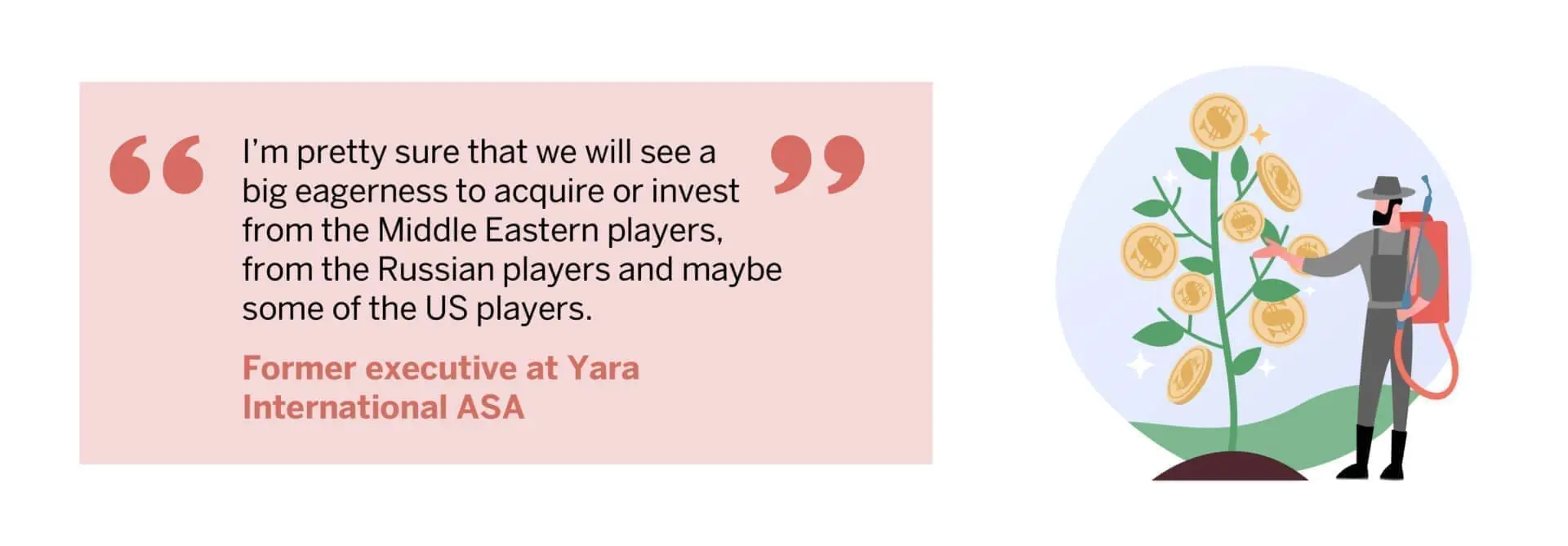At the same time, the prices of major crops such as corn and soybeans reached multi-year highs, attracting many farmers to invest more in their farming inputs. Others who are less confident they’ll get a return on that investment have been holding off, planting the same acreage but receiving less yield in the hope that their costs will normalise. If they purchase too late, however, their yields could be impacted. And a sudden rush to buy products closer to spring could create further supply-chain shocks when the industry needs smoothness most.
Pushback on sky-high prices was apparent in Q4 as restocking for Q1/Q2 2022 crop inputs slowed in Europe. This suggested many farmers “believe that there will be enough product and they can get it later, which is not likely, or they are just buying parts of what they need now and then will try to buy more later or reduce the total amount,” a former executive at Yara International told Forum in October.
Given the skyrocketing price of natural gas in Europe – the main culprit behind soaring production costs – many fertiliser players have faced tough decisions about whether they can justify keeping their plants running. With costs exploding 300% since March 2021 due to high demand and low supply, some manufacturers were forced to curtail production, such as Yara International.[mfn]https://www.fb.org/market-intel/too-many-to-count-factors-driving-fertilizer-prices-higher-and-higher [/mfn] Yara’s European ammonia business was approximately 30% below capacity from September to November, but as of mid-December it was mostly back on stream.[mfn]https://www.yara.com/corporate-releases/yara-ammonia-curtailment-volumeupdate/ [/mfn] The only producer of ammonium nitrate in the UK, CF Industries, also shuttered its two plants in September.[mfn] https://www.ft.com/content/7dae8fdc-bc09-4322-80f9-fde081508235 [/mfn] The ramifications of such closures continue to be felt far and wide. As the aforementioned expert noted, “every tonne that doesn’t get produced is lost for next season”.
Gas prices in North America, particularly Canada, were more stable during the period. “From a cost, and pure manufacturing perspective, North American production is looking pretty good,” a former senior director at Nutrien said. “It’s cheap from a nitrogen perspective.” However, the region is still feeling the effects of global supply issues, with the Texas Arctic blast in February and Hurricane Ida in August having also disrupted production.
All these factors have given fertiliser producers strong pricing power, reaching levels not seen since the 2008/09 financial crisis. For example, spot prices for standard ammonium nitrate fertiliser were GBP 213 a tonne in October 2020 and by December 2021 hit GBP 615 a tonne.[mfn] https://www.ft.com/content/7dae8fdc-bc09-4322-80f9-fde081508235 [/mfn] Although prices are unlikely to remain elevated to this extent long term, they are expected to be higher this spring versus the prior year, the former Nutrien director told us. Indeed, “we’ve seen that the crop prices have increased but much less than fertiliser prices”, the former Yara executive noted. “This is the first time, since 2008, that those two indexes have reversed, meaning the fertiliser prices are relatively [speaking] much higher than crop prices.”
Crop prices have been pushed up by major global usage, including strong demand from China, coupled with low inventories. Meanwhile, a tight logistics and transportation market has made it even more difficult to meet this growing demand. Adverse weather events, labour shortages, manufacturing capacity and infrastructure breakdowns, including rail logistics and increased freight rates, have exacerbated production and distribution challenges in the fertiliser space.

This level of disruption and uncertainty could have long-term CAPEX implications for some businesses, particularly in light of the EU Emissions Trading System. As we heard in the Interview with the former Yara executive, companies focused on the Euro region might now “think twice” about upgrading their plants. “They might slow down a bit and consider, for example, instead of doing CCS [carbon capture and storage] on ammonia, shutting it down and importing ammonia.” The specialist also remarked that many Russian companies are “making a lot of money” and looking for projects. “I’m pretty sure that we will see a big eagerness to acquire or invest from the Middle Eastern players, from the Russian players and maybe some of the US players,” they added.
Exactly how the gas crisis and curtailments impact crop yields in 2022 will soon be discovered, particularly with many farmers taking a wait-and-see approach when it comes to buying products. From a fertiliser pricing perspective, “you’d like to be able to say… that this is going to last, but history would say different”, the former Nutrien director said. Indeed, it’s a question of “how long until it falls and how fast it falls”, we heard.
But with so many factors at play, it’s difficult to predict exactly how the operating environment might change this year and beyond. Based on 2021 events, the former Yara executive expects the beginning of the 2022/23 season to be characterised by low stocks of fertiliser and low food. “So if everything normalises, it’s still expected to be a good year with above USD 300 urea prices and with good demand early in the season,” they said. “If everything normalises in terms of gas prices, it should be a really profitable season, even for European companies.” Looking ahead to 2023-24, a return to regular planting activities in the prior season is expected to push inventories back into surplus territory and bring margins down to more normal levels. “What is normal? A 2017, maybe, type situation.”
The information used in compiling this document has been obtained by Third Bridge from experts participating in Forum Interviews. Third Bridge does not warrant the accuracy of the information and has not independently verified it. It should not be regarded as a trade recommendation or form the basis of any investment decision.
For any enquiries, please contact sales@thirdbridge.com



